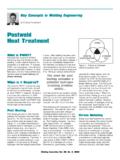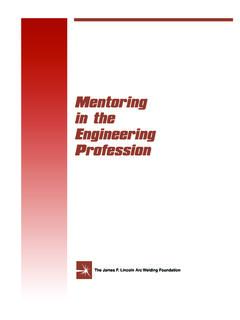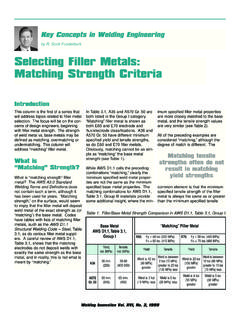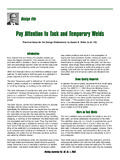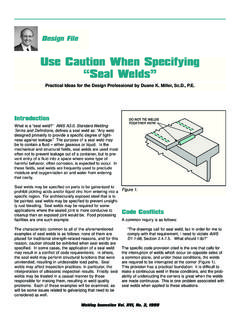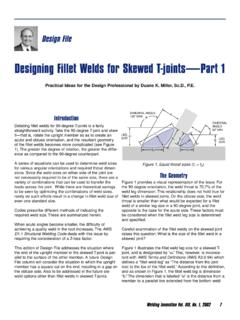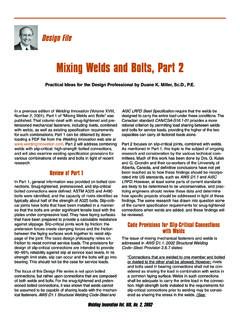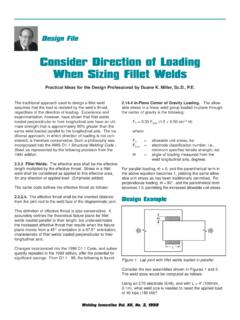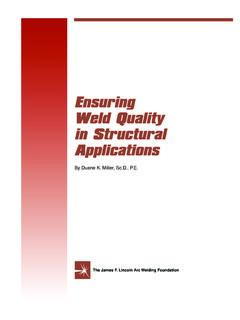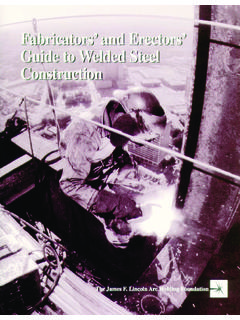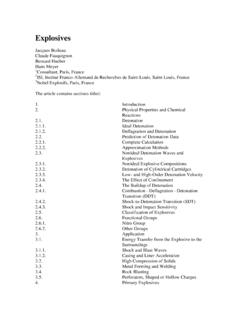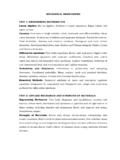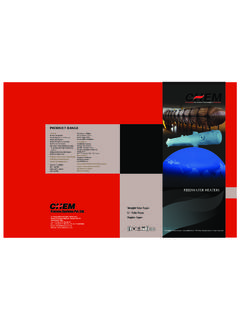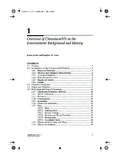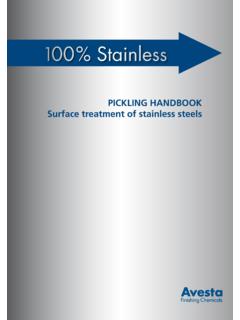Transcription of A publication of the James F. Lincoln Arc Welding …
1 A publication of the James F. Lincoln Arc Welding FoundationVolume XX, Number 1, 2003 Donut Consumption 101 Australia and New ZealandRaymond K. RyanPhone: 61-2-4862-3839 Fax: 61-2-4862-3840 CroatiaProf. Dr. Slobodan KraljPhone: 385-1-61-68-222 Fax: 385-1-61-56-940 RussiaDr. Vladimir P. YatsenkoPhone: 077-095-737-62-83 Fax: 077-093-737-62-87 INTERNATIONAL SECRETARIESThe manufacturing, construction and miningindustries that use Welding technologytogether account for about one-third of Gross Domestic Product, yet most companies in these fields have never done a thorough study of their Welding costs, norhave they ever evaluated the contribution of Welding to their complete manufacturingprocess.
2 The preceding statements aremade and supported in a comprehensivestudy* published jointly last year by theAmerican Welding Society and the EdisonWelding fundamentally, when it comes to Welding , most manu-facturers don t know how much they re spending, or whatthey re actually spending it even s the badnews. Now for the good news: the same study found thatcompanies with a solid understanding of the value weldingcan add to the manufacturing process, as well as a firmgrasp of Welding economics, are able to compete success-fully, both nationally and most readers of this publication know the firstrule of Welding economics that in the , laboraccounts for over 70 percent of total Welding Welding costs are compared to a donut, by attempting tochip away at equipment and consumable costs, manufac-turers are focusing on the hole.
3 The only way to trulyreduce costs is to take a big bite of the donut itself thelabor costs. This is done by raising Ways to Dunk the DonutOpportunities for increasing Welding productivity fall intothree broad categories: automation, design and AWS/EWI study cites automation as the first route tohigher productivity, and yet it states, nearly 60% of allfirms reported no effort to actively pursue the automationof Welding processes. It observes that most companieswait for industry leaders to take the capital risks ofautomating, and then only gradually, after seeing provenresults, adopt automated Welding requirements should be fundamentalto every phase of designing a structure or product.
4 AsWelding Innovation design consultant Omer Blodgett says, If the engineer makes the mistake of considering weldingto be just another type of fastener, the item or structure asdesigned will fall far short of its potential is not a fastener; it is method of designwhich, properly used, takes full advantage of theversatility of the material. Qualified Welding personnel are in chronically shortsupply and almost half of the firms responding tothe study said their Welding -related training needsare not being met. Manufacturers cited shortagesof qualified personnel and a lack of advanced weld-ing education programs at every level of the field,from apprentice welder to the First Few BitesSince 1936, the James F.
5 Lincoln Arc Welding Foundationhas been dedicated to enlarging the market for Welding byrewarding achievement and sharing technical , we enthusiastically endorse the recommendationsin the AWS/EWI study, especially proposed efforts to: Develop procedures to help companies understand theeconomics of adding value by raising Welding productivity. Identify and pursue improved educational opportunities inthe field of Welding at local, state, and national levels. Coordinate efforts to share knowledge of productive weld-ing practices between and among different readers of Welding Innovationappreciate the factthat many of these objectives are addressed in the pages ofthis magazine, through such columns as Lessons Learned inthe Field, Design File, and feature stories profiling a broadrange of exceptional projects.
6 So if we re preaching to thechoir, please pass this magazine on to someone whom youthink might need to hear the , Wake Up and Smell the CoffeeWhen times are good and business is booming, it seemswe re always too busy to focus on innovation. And when busi-ness is bad, we lack cash to invest in anything that doesn tpromise an immediate return. But when it comes to innova-tion, there is no time like the present. Understand the trueeconomic issues, grasp the fundamental design concepts,and begin a serious study of it D. Seif, Vice President, Sales and Marketing, The Lincoln Electric Company* Welding -Related Expenditures, Investments, and ProductivityMeasurement in US.
7 Manufacturing, Construction, and MiningIndustries, May Innovation Vol. XX, No. 1, 2003 Cover: The William Jefferson ClintonPresidential Center in Little Rock,Arkansas features two massive paralleltrusses that were fabricated in individualpieces and then assembled in the air, in the vertical position. Photo: ArkansasAerial Photography. Story on page views and opinionsexpressed in WeldingInnovationdo not neces-sarily represent those ofThe James F. Lincoln ArcWelding Foundation or TheLincoln Electric serviceability of aproduct or structure utiliz-ing the type of informationpresented herein is, andmust be, the sole responsi-bility of the variables beyond thecontrol of The James Arc WeldingFoundation or The LincolnElectric Company affect theresults obtained in applyingthis type of variables include,but are not limited to, weld-ing procedure, plate chem-istry and temperature,weldment design, fabrica-tion methods, and XXNumber 1, 2003 EditorDuane K.
8 Miller, , James F. Lincoln Arc Welding FoundationOmer W. Blodgett, , ConsultantFeaturesDepartmentsVisit us online at James F. Lincoln ARC Welding FOUNDATIONDr. Donald N. Zwiep, ChairmanOrange City, IowaJohn Twyble, TrusteeMosman, NSW, AustraliaRoy L. MorrowPresidentDuane K. Miller, , , Trustee, Cleveland OhioCarl PetersExecutive Director7 Opportunities: Lincoln Electric Technical Programs8 Design File: Pay Attention to Tack and Temporary Welds13 Opportunities: Lincoln Electric Professional Programs14 Lessons Learned in the Field: Understanding Distortion is a Never Ending Challenge2 Repair and Maintenance Procedures for Heavy Machinery ComponentsThe hardfacing process is a cost-effective tool that can minimize wear and increase service life of heavy machinery the Essential Connections on "A Bridge to the 21st Century"Fabrication and erection of the $160 million Clinton Presidential Library represents the value of meticulous planning, coordination and precision Innovation Vol.
9 XX, No. 1, 2003 Repair and Maintenance Proceduresfor Heavy Machinery ComponentsA version of this paper was publishedat the 50th WTIA Annual Conferenceheld in Sydney, Australia, 26-30 August machinery components aresubjected to severe destructive condi-tions of environmental wear. The hardfacing process is a cost-effectivetool that can minimize wear andincrease service life of heavy of WearThe OECD (Organisation forEconomic Cooperation andDevelopment) defines wear as: Theprogressive loss of substance from theoperating surface of a body occurringas a result of relative motion at thesurface [1]. Commonly recognizedwear categories and their respectiveestimated shares of heavy machinerywear [2] are shown in Figure , there are several wear mech-anisms that act simultaneously onheavy machinery components.
10 Thetwo most common types are abrasiveand metal to metal to Metal WearMetal to metal wear occurs when twometallic surfaces slide against eachother under the pressure. True metalto metal wear is the most often foundunder nonlubricated or dry s Metal to Metal Theory hasbeen widely accepted since the rela-tionship established between the wearvolume (V), sliding distance (L), nor-mal load (N) and hardness (H) is con-sistent with experimentally observedresults:V=(KxLxN)/H (1)K is coefficient of shear stresses overcome thecohesive strength of the metal matrix,cracks and voids can be nucleatedand wear particles can form [4].
